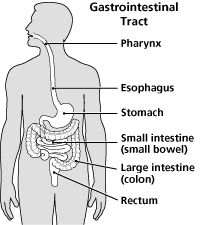Parts of the GIT and their Functions
Dr.A.P.Ganesan
Komarapalayam
Mention the different parts of parts of Gastrointestinal Tract with the help of a diagram and briefly explain their functions.
Parts of the GIT
1. Mouth
2. Pharynx
3. Esophagus
4. Stomach
5. Small intestine - Duodenum, Jejunum, Ileum
6. Large intestine - Caecum, ascending colon, transverse colon, descending colon, Sigmoid colon
7. Rectum, anal canal and anus
Functions of mouth
a) Ingestion of food materials
b) Chewing and mixing of food with saliva
c) Appreciation of the taste of food
d) Swallowing of food
Functions of pharynx
a. Taste of food
b. Swallowing of food
Function of esophagus
Transport of food from pharynx to stomach during the act of swallowing
Functions of stomach
a. Storage function: acts as a reservoir for food
b. Mechanical function : by movements of stomach, the food gets mixed with gastrid juice and gets converted into chyme.
c. Stomach propels the food into the intestine
d. Digestive function : Gastric glands secrete gastric juice which contain digestive enzymes. The enzymes digest the food, The HCl present in the stomach hydrolyses the food.
e. Absorptive function : Stomach absorbs water, glucose, salin, alcohol and some drugs
f. Protective function: (Bacteriolytic) HCl present in the gastric juice destroys many types of bacteria entering the body with food.
g. Haemopoietic functions : Gastric mucosa seretes intrinsic factor for maturation of the RBCs
h. Excretory function : Many substances likke drugs, heavy metal and toxins are excreted through gastric juice
Functions of Small Intestine
a. Mechanical function : Peristaltic movements of small intestine help mixing of chyme with digestive juices like succus entericus and pancreatic juices.
b. Secretory function : Small intestine secretes succus entericus and GI hormones
c. Hormonal functions : Small intestine secretes hormones like enterogastrin, secretin, cholecystokinin.
d. Digestive function : The digestion of food is completed in the small intestine by the enzymes present in succus entericus and pancreatic juice.
e. Activator function : Small intestine secretes enterokinin which activates trypsinogen into trypsin
f. Haemopoietic function Small intestine absorbs intrinsic factor which is necessary fo the absorption of Vit B12. It is necessary for maturationof RBCs.
g. Hydrolytic functions : Succus entericus provides water and helps in all hydrolytic process of enzymatic reactions of foods
h. Absorptive function : The following are absorbed by the small intestine : digested products of carbohydrates, proteins, fats, minerals, vitamins, water and other nutrients.
Functions of Large intestine
Secretory functions : Large Intestine secretes mucin, inorganic substances like chlorides and bicarbonates
Synthetic function the bacterial flora in L.I. synthesize Folic acid, Vitamin B12 and Vitamin K
Absorbtive function : In large intestine water glucose, alcohol, some drugs, anesthetic agents, sedatives steroids are absorbed
Excretory function : L. I. excretes heavy metals like Hg, Pb, Bi, Ar through faeces
After absorption of nutrients, water and other substances, the unwanted substances form faeces which is excreted out.
* * * * * * * * * * * * * * * *


